Infield Drills - Bunt Defense Is Dependent On The Situation:
Relatively speaking there are few Infield Drills which affect every player on the infield more than Setting A Bunt Defense and I’m somewhat embarrassed to say it took a little league player to point that out to me in a way I actually understood.
Traditionally, every year our baseball association secures a block of tickets for a St. Louis Cardinals Ball game, which all the coaches took our players to enjoy a night of baseball and fun, and although we were in the nose bleed section along with the birds, nobody really cared.
I was watching the players move around the infield, not really thinking about what they were doing, when one of players commented the players looked like a bunch of ants running around and asked why they were all moving at the same time.
What we had observed was the visiting team attempting a sacrifice bunt, and luckily it was a failed attempt and they had to try it again, which gave me time to somewhat explain what was happening on the infield.
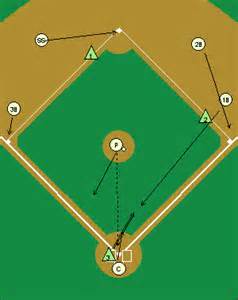
One Example Of Bunt Defensive Moves -
Infield Drills
I must admit, although I had participated in the identical maneuvers the
fielders were performing a thousand times, I hadn’t really paid a lot
of attention as to how confusing it must have looked to a person
uneducated on what was transpiring and why, until the player’s remark,
but he was definitely correct in his analysis of the situation. It
appeared to be a bunch of ants running around chaotic.
Let’s learn some basic defensive maneuvers in order to combat the bunt.
Analyzing and Setting a Bunt Defense which dictates the Infield Drills is the first step in learning bunt defense.
Initially a coach must realize “Circumstances dictate a Bunt Defensive Alignment,” and what I mean by that is, we’re not talking the surprise, bunt for a hit circumstance, there is no per se’ defensive alignment for that…only execution of excellent athletic skills in fielding and throwing.
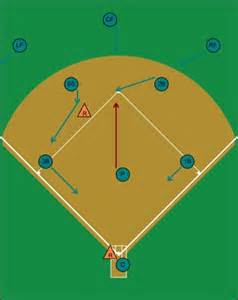
We’re focusing on the anticipated Sacrifice Bunt situation:
(1.) What is the opponent attempting to accomplish by using this play …
(2.) Circumstances will dictate the opponent’s motive …
(3.) Our defense is intended to counter the opponent’s goal …
(4.) We’ll examine several different circumstances, situations, offensive and defensive goals, which will dictate each infielders’ responsibility, movement and intention, which will constantly change.
Situation One: Standard Sacrifice Bunt Defense and Infield Drills
The most common circumstance which would prompt a team to give up an out created by the Sacrifice Bunt, is to move an existing runner on first base over to second base, where he is in better position of scoring on a hit to the outfield.
A good coach will only call for this play in either a tight ball game or if he knows the historic pitchers match up and anticipates a low scoring game.
Although there’s always exceptions to the rules, a slugfest, 12 - 9 game rarely prompts a sacrifice bunt situation.
The defensive alignment for this situation is relatively standard, but let’s learn the player’s general responsibilities by position.
Pitcher:The pitcher will have numerous responsibilities which continue to change as the play develops:
(1.) Initially, he must attempt to keep the base runner as close to first base as possible, by throwing over to first, holding the stretch position for a long time, or stepping off the rubber.
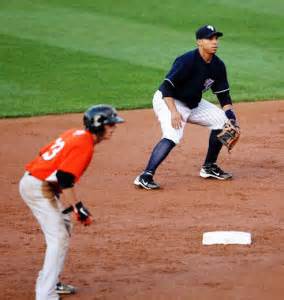
Second Baseman Keeping Runner Close
Infield Drills
The runner will be trying to get a good jump towards second base when the ball is bunted … the pitcher wants him glued to first base.
(2.) He should always attempt to throw a waist high or higher pitch, preferably a fastball, because of the elevation, above the hands, and the speed, it is the hardest pitch for the bunter to get on top of and bunt the ball downward on the ground. Many high pitches result in high infield pop flies or a line drive back to the fielder.
(3.) Once the pitcher has completed his delivery, without hesitation, he is to charge forward towards the plate in order to field a ball bunted straight out towards the mound.
First Baseman: The First Baseman helps the pitcher keep the runner as close to first base as possible by offering a good target for the pitcher to aim at should he attempt a pick off throw. Remember, some pitchers require a target to throw at because they’re accustomed of throwing at the catcher’s target.
(2.) Of course he must be prepared to receive a quick pick off throw with the intent of putting a quick swipe tag on the runner, but secondarily and nearly as important, he Must block any wild throw to first base.
A throw getting past the first baseman would allow the runner to advance to second and most likely continue on to third base, which could for all practical purposes, give the opposition a run.
(3.) Infield Drills rarely include this skill, but should. The first baseman must delay moving into his fielding position as long as possible. Regardless of where the fielder is going, he will leave the base the split second he knows the pitcher is throwing home.
Clickbank Products
In most cases because the two players work together all the time, the first baseman will know before the runner, the pitcher is going to the plate. A smart runner will anticipate the first baseman leaving the base and will begin to immediately increase his lead off the second he does. Therefore remain at the base as long as possible in order to keep the runner close as long as possible.
(4.) As the pitcher commits to throwing to the plate, the first baseman must rush as quickly as possible towards the plate in order to field a ball bunted down the first base line.
Second Baseman: Infield Drills and Bunt Defense
The second baseman will initially play a shallower or closer into the infield position than his normal fielding position, which will be in line, or slightly behind, the first to second base path.
The second baseman’s job is to move over and cover the vacated first base position, because the first baseman has charged the plate, and simply receive the Put Out throw from whoever eventually fields the bunted baseball.
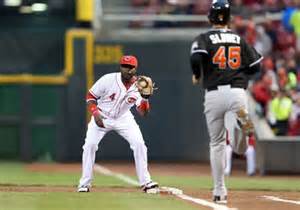
Infield Drills - Second Baseman Covering First
But is it really that simple. Of course not, as there is a little Cat and Mouse game being played between the fielder, batter and opposing coaches.
The second baseman must be wary and Can Not break for first base too soon, or run the risk of the anticipated bunt becoming a slap swing, driving the ball through the vacated second base position, advancing the runner to third and allowing a hitter to reach safely.
Should you question a batter’s ability to place a ball, watch girl’s softball. You’ll be amazed at their near pinpoint control by slap hitting, and there’s no reason a baseball batter couldn’t do the same.
Therefore, the fielder must first determine the ball is in fact bunted, then quickly run to cover first base, offering a steady target for the other fielder to throw. It is imperative the fielder does not have to wait for the second baseman to reach first before throwing, as this could easily result in either the batter beating the throw or forcing the fielder to double pump, destroying his timing and flow, creating a wild throw to first.
Short Stop: Infield Drills for the Short Stop are similar to the second baseman, as their responsibilities often mirror one another. He will play a Shallow position, or slightly behind the second to third base path.
No different than the second baseman, and possibly more important, when the ball is bunted, the Short Stop must immediately go to cover second base in case there is a throw from the fielder.
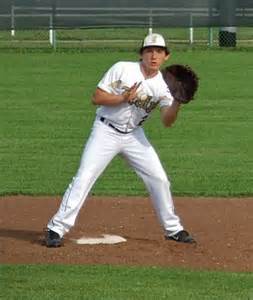
Infield Drills - Shortstop Covering Second Base
The reason I mention More Important is in most cases, if not all, the throw to second base will require the fielder to instantaneously throw the ball to second base and any delay waiting for the shortstop eliminates getting an out at second. In most cases, the fielder will have longer to throw to first base and still get the out.
A mental note here. It’s important the shortstop be mentally prepared as to what his job is. Normally, unless it’s a double play scenario, this fielding position is normally associated with receiving a throw from the direction of the catcher, in order to tag out a base stealer, it’s important the player remember this is a Force Out situation with no need to tag the runner.
Third Baseman: The third baseman begins by playing a Shallow position, probably 4 to 5 feet in front of the base, slowly creeps forward as the pitcher assumes his stretch position, then charges toward the plate as the hitter squares to bunt.
Tradition states the third baseman should be able to shake hands with the bunter as he makes contact with the ball, but tradition must not have ever experienced the sheer terror of a hitter switching off the bunt and taking a Full Swing.
Infield Drills which teach Run quickly, but wisely are in order. Don’t Assume the bunt is automatic, but rather keep your head up and eyes forward as you advance.
Catcher: Would it surprise anyone if I said the infield drills a Catcher must learn has the most responsibility of any of the other fielders … didn’t think so.
Initially, the catcher normally has the responsibility of relaying the Coach’s instructions to the fielders by calling the defensive set, which means he must know where player should be positioned. Assuming his position behind the plate, he must quickly check to insure everyone is positioned correctly, or call time out and clarify the instructions.
Giving signals should only be a formality, as a high fastball should be standard, but the catcher’s eyes will constantly dart back and forth between the pitcher and the runner. Knowing the importance of keeping the runner close, should he decide the runner has too large of a lead, he’ll signal the pitcher to throw over to first. Should that signal be missed or ignored by the pitcher, the catcher will call time out and address the issue with the pitcher.
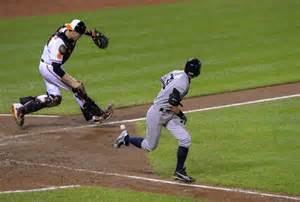
Infield Drills - Catcher Fielding Bunt
Upon the ball being bunted on the ground, one of two scenarios immediately happen.
(1.) The ball is barely pushed out in front of the plate and the catcher is able to field the bunted ball, since he’s facing second base, and his first instinct should be to throw to second for the force out of the lead runner, he will make the throw to second base.
Or, deciding he can not throw out the lead runner, or the play would be too close to chance, he will move into the infield far enough to make the throw to first base without the runner interfering with the throw or second baseman’s view of the ball.
(2.) The second the catcher knows he can not field the ball, because he is looking forward which allows him to see the entire field, he will quickly scan and analyze what‘s unfolding, and upon his decision he Yells directions to the fielder of where to throw the ball.
This is the most common Bunt Defense alignment and fielder responsibilities, but only one as circumstances will force the alteration of this defense.
"Although getting the Lead Runner Out is Always the Primary Goal in a Sacrifice Bunt...Always Be Sure to Get 1 Out for Sure"
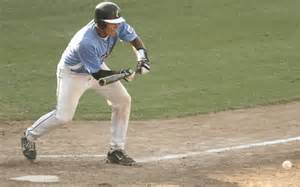
Infield Drills - Everybody Starts Moving
Runners On First and Second Base: and Infield Drills
There are circumstances which will prompt a manager to call for a sacrifice bunt with runners on first and second base such as a weaker hitter at bat, or the desire to stay out of a double play because the batter is extremely slow, are but a couple of reasons.
In order to counter this Sacrifice Bunt maneuver, the opposing manager may decide to call for a different Bunt Defense than what’s normal.
This particular defensive alignment will alter the Second Baseman and Shortstop assignments and will affect the outfielders. Yes, a bunt has an impact on the outfield.
These are some of the scenarios this defensive alignment can create.
The Second Baseman …. will Not go to cover first base, as before, but rather will go to cover Second base.
The Short Stop, instead of going to cover second base, goes instead to cover Third Base.
(1.) Here’s the philosophy behind the moves. Should the bunted ball not be perfectly placed, it is the defenses’ hope a charging infielder can quickly field the ball and throw to Third Base forcing the lead runner out.
(2.) The Catcher fields the ball, throwing to Second for a force out, which the Second Baseman then relays to First Base to complete a Double Play.
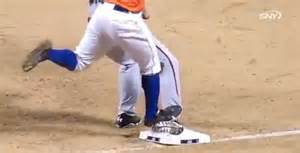
Infield Drills - Believe It Or Not That's The Right Fielder Covering First Base
Wait, Who is covering First Base? The Right Fielder, who originally positioned himself in a shallow right field, then the instant he sees the First Baseman break towards the plate, he runs in to cover first base.
The Left Fielder comes in to back up Third Base, the Center Fielder Second Base, in the event of a wild throw to either base. Everyone has a job.
(3.) Upon making the Force Out at Second Base and preparing to throw to First Base for the Double Play, the second baseman sees the runner on third attempting to score.
This is a judgment call by the Second Baseman on how he proceeds with the play and is based on the assumption there is only 1 out, the force out, or else he’ll probably automatically throw to first base to complete the double play for the third out.
Should the runner be only a third of the way down the baseline towards home and could be trying to stop the double play, not actually attempt to score, the Second Baseman should Run Directly towards the runner.
This action will force the runner to stop, attempt to score or attempt to retreat to third base. Should it be retreat, immediately throw to the short stop, who is covering third base.
Should the runner attempt to score, continue running at him until he is committed to Home Plate, then throw home to the catcher. At that point, peel off because you’re no longer involved in the play, whether it be a collision at Home or a Run Down.
There is another whole segment on “How to Perform Rundowns” but this will give you the idea.
Always Remember To Hold The Baseball Out Away From Your Body So Your Team Mates Can Clearly See It.
These are some of the different Bunt Defense plays which a Coach can call based on 1 play … a sacrifice bunt.
Infield Drills back to Baseball Skill Drills

New! Comments
Have your say about what you just read! Leave me a comment in the box below.